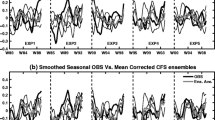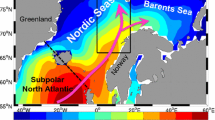Abstract
The South Pacific Ocean is a key driver of climate variability within the Southern Hemisphere at different time scales. Previous studies have characterized the main mode of interannual sea surface temperature (SST) variability in that region as a dipolar pattern of SST anomalies that cover subtropical and extratropical latitudes (the South Pacific Ocean Dipole, or SPOD), which is related to precipitation and temperature anomalies over several regions throughout the Southern Hemisphere. Using that relationship and the reported low predictive skill of precipitation anomalies over the Southern Hemisphere, this work explores the predictability and prediction skill of the SPOD in near-term climate hindcasts using a set of state-of-the-art forecast systems. Results show that predictability greatly benefits from initializing the hindcasts beyond the prescribed radiative forcing, and is modulated by known modes of climate variability, namely El Niño-Southern Oscillation and the Interdecadal Pacific Oscillation. Furthermore, the models are capable of simulating the spatial pattern of the observed SPOD even without initialization, which suggests that the key dynamical processes are properly represented. However, the hindcast of the actual phase of the mode is only achieved when the forecast systems are initialized, pointing at SPOD variability to not be radiatively forced but probably internally generated. The comparison with the performance of an empirical prediction based on persistence suggests that initialization may provide skillful information for SST anomalies, outperforming damping processes, up to 2–3 years into the future.








Similar content being viewed by others
References
Barros VR, Silvestri GE (2002) The relation between sea surface temperature at the subtropical south-central Pacific and precipitation in southeastern South America. J Clim 15:251–267
Basher RE, Zheng X (1998) Mapping rainfall fields and their ENSO variation in data-sparse tropical south-west Pacific Ocean regions. Int J Climatol 18:237–251
Boer GJ et al (2016) The Decadal Climate Prediction Project (DCPP) contribution to CMIP6. Geosci Model Dev 9:3751–3777
Boisier JP, Rondanelli R, Garreaud RD, Muñoz F (2016) Anthropogenic and natural contributions to the Southeast Pacific precipitation decline and recent megadrought in central Chile. Geophys Res Lett 43:413–421
Chung CTY, Power SB, Sullivan A, Delage F (2019) The role of the South Pacific in modulating Tropical Pacific variability. Sci Rep 9:18311
Ding H, Greatbach RJ, Latif M, Park W, Gerdes R (2013) Hindcast of the 1976/77 and 1998/99 climate shifts in the Pacific. J Clim 26:7650–7661
Doblas-Reyes FJ, Andreu-Burillo I, Chikamoto Y, García-Serrano J, Guemas V, Kimoto M, Mochizuki T, Rodrigues LRL, van Oldenborgh GJ (2013) Initialized near-term regional climate change prediction. Nat Commun 4:1715. https://doi.org/10.1038/ncomms2704
Du H, Doblas-Reyes FJ, García-Serrano J, Guemas V, Soufflet Y, Wouters B (2012) Sensitivity of decadal predictions to the initial atmospheric and oceanic perturbations. Clim Dyn 39:2013–2023
García-Serrano J, Doblas-Reyes FJ (2012) On the assessment of near-surface global temperature and North Atlantic multi-decadal variability in the ENSEMBLES decadal hindcast. Clim Dyn 39:2025–2040
García-Serrano J, Doblas-Reyes FJ, Coelho CAS (2012) Understanding Atlantic multi-decadal variability prediction skill. Geophys Res Lett 39:L18708
García-Serrano J, Guémas V, Doblas-Reyes FJ (2015) Added-value from initialization in predictions of Atlantic multi-decadal variability. Clim Dyn 44:2539–2555
García-Serrano J, Cassou C, Douville H, Giannini A, Doblas-Reyes FJ (2017) Revisiting the ENSO teleconnection to the tropical North Atlantic. J Clim 30:6945–6957
González PLM, Goddard L (2016) Long-lead ENSO predictability from CMIP5 decadal hindcasts. Clim Dyn 46:3127–3147
Gordon C, Cooper C, Senior CA, Banks H, Gregory JM, Johns TC, Mitchell JFB, Wood RA (2000) The simulation of SST, sea ice extents and ocean heat transports in a version of the Hadley Centre coupled model without flux adjustments. Clim Dyn 16:147–168
Grimm AM, Barros VR, Doyle ME (2000) Climate variability in southern South America associated with El Niño and La Niña events. J Clim 13:35–58
Guan Y, Zhu J, Huang B, Hu ZZ, Kinter JL III (2014) South Pacific Ocean Dipole: a predictable mode on multiseasonal time scales. J Clim 27:1648–1658
Guémas V, Doblas-Reyes FJ, Lienert F, Soufflet Y, Du H (2012) Identifying the causes of the poor decadal climate prediction skill over the North Pacific. J Geophys Res Atmos 117:D20111
Guémas V, Corti S, García-Serrano J, Doblas-Reyes FJ, Balmaseda MA, Magnusson L (2013) The Indian Ocean: the region of highest skill worldwide in decadal climate prediction. J Clim 26:726–739
Hasumi H, Emori S (2004) K-1 coupled GCM (MIROC) description. K-1 technical report 1. University of Tokyo, Tokyo, p 34
Hou Z, Li J, Ding R, Karamperidou C, Duan W, Liu T, Feng J (2018) Asymmetry of the predictability limit of the warm ENSO phase. Geophys Res Lett 45:7646–7653
Huang B, Shukla J (2006) Interannual SST variability in the southern subtropical and extra-tropical ocean. Technical report 223, Center for Ocean-Land-Atmosphere Studies, Calverton
Jin EK, Kinter JL III, Wang B et al (2008) Current status of ENSO prediction skill in coupled ocean-atmosphere models. Clim Dyn 31:647–664
Kayano MT, de Oliveira CP, Andreoli RV (2009) Interannual relations between South American rainfall and tropical sea surface temperature anomalies before and after 1976. Int J Climatol 29:1439–1448
Kim H-M, Webster PJ, Curry JA (2012) Evaluation of short-term climate change prediction in multi-model CMIP5 decadal hindcasts. Geophys Res Lett 39:L10701
Kirtman B, Power S, Adedoyin JA, Boer GJ, Bojariu R, Camilloni I, Doblas-Reyes FJ, Fiore AM, Kimoto M, Meehl GA, Prather M, Sarr A, Schär C, Sutton R, van Oldenborgh GJ, Vecchi G, Wang HJ (2013) Near-term climate change: projections and predictability. Climate change 2013: the physical science basis. In: Stocker TF, Qin D, Plattner GK, Tignor M, Allen SK, Boschung J, Nauels A, Xia Y, Bex V, Midgley PM (eds) Contribution of working group I to the fifth assessment report of the intergovernmental panel on climate change. Cambridge University Press, Cambridge, pp 953–1028. https://doi.org/10.1017/CBO9781107415324.023
Krishnamurthy V, Misra V (2010) Observed ENSO teleconnections with the South American monsoon system. Atmos Sci Lett 11:7–12
Lienert F, Doblas-Reyes FJ (2013) Decadal prediction of interannual tropical and North Pacific sea surface temperature. J Geophys Res Atmos 118:5913–5922
Linsley BK, Wellington GM, Schrag DP, Ren L, Salinger MJ, Tudhope AW (2000) Geochemical evidence from corals for changes in the amplitude and spatial pattern of South Pacific interdecadal climate variability over the last 300 years. Clim Dyn 22:1–11
Lou J, Holbrook NJ, O’Kane TJ (2019) South Pacific decadal climate variability and potential predictability. J Clim 32:6051–6069
Müller WA, Pohlmann H, Sienz F, Smith D (2014) Decadal climate prediction for the period 1901–2010 with a coupled climate model. Geophys Res Lett 41:2100–2107
Osman M, Vera CS (2020) Predictability of extratropical upper-tropospheric circulation in the Southern Hemisphere by its main modes of variability. J Clim 33:1405–1421
Power S, Casey T, Folland C, Colman A, Mehta V (1999) Inter-decadal modulation of the impact of ENSO on Australia. Clim Dyn 15:319–324
Power S, Haylock M, Colman R, Wang X (2006) The predictability of interdecadal changes in ENSO activity and ENSO teleconnections. J Clim 19:4755–4771
Power S, Saurral RI, Chung C, Colman R, Kharin V, Boer G, Gergis J, Henley B, McGregor S, Arblaster J, Holbrook N, Liguori G (2017) Towards the prediction of multi-year to decadal climate variability in the Southern Hemisphere. Past Glob Changes Mag 25:32–40
Rayner NA, Parker DE, Horton EB, Folland CK, Alexander LV, Rowell DP, Kent EC, Kaplan A (2003) Global analyses of sea surface temperature, sea ice, and night marine air temperature since the late nineteenth century. J Geophys Res D Atmos.https://doi.org/10.1029/2002JD002670
Ropelewski CF, Halpert MS (1987) Global and regional scale precipitation patterns associated with El Niño/Southern Oscillation. Mon Wea Rev 115:1606–1626
Saurral RI, Doblas-Reyes FJ, García-Serrano J (2018) Observed modes of sea surface temperature variability in the South Pacific region. Clim Dyn 50:1129–1143
Schubert SD, Suarez MJ, Pegion PJ, Kistler MA, Kumar A (2002) Predictability of zonal means during boreal summer. J Clim 15:420–434
Shakun JD, Shaman J (2009) Tropical origins of North and South Pacific decadal variability. Geophys Res Lett 36:L19711
Smith DM, Eade R, Dunstone NJ, Fereday D, Murphy J, Pohlmann H, Scaife AA (2010) Skilful multi-year predictions of Atlantic hurricane frequency. Nat Geosci 3:846–849
Smith DM, Eade R, Scaife AA, Caron LP, Danabasoglu G, DelSole TM, Delworth T, Doblas-Reyes FJ, Dunstone NJ, Hermanson L, Kharin V, Kimoto M, Merryfield WJ, Mochizuki T, Müller WA, Pohlmann H, Seager S, Yang X (2019) Robust skill of decadal climate predictions. Npj Clim Atmos Sci 2:13
Srivastava A, DelSole T (2018) Decadal predictability without ocean dynamics. PNAS 114:2177–2182
Taylor KE, Stouffer RJ, Meehl GA (2012) An overview of CMIP5 and the experiment design. Bull Am Meteorol Soc 93:485–498
Tedeschi RG, Collins M (2016) The influence of ENSO on South American precipitation during austral summer and autumn in observations and models. Int J Climatol 36:618–635
Vera CS, Silvestri GE, Barros VR, Carril AF (2004) Differences in El Niño response over the Southern Hemisphere. J Clim 17:1741–1753
Volpi D, Doblas-Reyes FJ, García-Serrano J, Guémas V (2013) Dependence of the climate prediction skill on spatio-temporal scales: internal versus radiatively-forced contribution. Geophys Res Lett.https://doi.org/10.1002/grl.50577
Volpi D, Guémas V, Doblas-Reyes FJ, Hawkins E, Nichols NK (2017) Decadal climate prediction with a refined anomaly initialization approach. Clim Dyn 48:1841–1853
Yang X, Rosati A, Zhang S, Delworth TL, Gudgel RG, Zhang R, Vecchi GA, Anderson WG, Chang YS, DelSole T, Dixon KW, Msadek R, Stern WF, Wittenberg AT, Zeng F (2013) A predictable AMO-like pattern in GFDL’s fully-coupled ensemble initialization and decadal forecasting system. J Clim 26:650–661
Zhang L, Delworth TL, Yang X, Gudgel RG, Jia L, Vecchi GA, Zeng F (2017) Estimating decadal predictability for the Southern Ocean using the GFDL CM2.1 model. J Clim 30:5187–5203
Acknowledgements
The authors would like to thank the two anonymous reviewers, whose comments and suggestions led to a significant improvement of the manuscript. This study also benefited from discussion with Fabian Lienert. It was supported by the University of Buenos Aires through Grant UBACYT-20020100100803, UBACYT-2002170100428BA, CONICET through PIP2009-00444, ANPCyT through Grants PICT07-00400 and PICT2016-1898, the EUCP (GA 776613) and PRIMAVERA (GA 641727) EU-funded projects, and the CLIMAX (Belmont Forum/ANR-15-JCL/-0002-01) Project. J.G-S was funded by the Spanish “Ramón y Cajal” programme (RYC-2016-21181). The authors acknowledge the Red Española de Supercomputación (RES) and PRACE for awarding access to Marenostrum 3 at the Barcelona Supercomputing Center through the HiResClim project, as well as the World Climate Research Programme’s Working Group on Coupled Modelling and the diverse climate modeling groups for producing and making available the model outputs used in this paper. The support given by Oriol Mula-Valls and Virginie Guémas at early stages of this research is particularly appreciated.
Author information
Authors and Affiliations
Corresponding author
Ethics declarations
Conflict of interest
The authors declare that they have no conflict of interest.
Additional information
Publisher's Note
Springer Nature remains neutral with regard to jurisdictional claims in published maps and institutional affiliations.
Appendix
Appendix
1.1 Leading mode of SST variability in the SP region in the forecast systems
Figure 9 shows the spatial pattern associated with the leading mode of interannual SST variability in the SP region in forecast year 1 of the (left) initialized and (right) uninitialized hindcasts. The resemblance of the Init vs. NoInit patterns in each forecast system indicates that the SPOD mode is internally generated by the models. Additional discussion on this issue can be found in the main text.
Leading mode of SST interannual variability in the SP region in (from top to bottom) DePreSys, EC-Earth, GFDL, HadCM3 and MIROC5, considering Init (left column) and NoInit (right column) experiments. The numbers in the sub-titles denote the fraction of variance explained by the mode in each case. The smaller numbers within each sub-figure indicate the spatial correlation between the simulated mode in the hindcast and the observed field. The computation of the leading mode was done taking, for each forecast system, all the ensemble members together
Rights and permissions
About this article
Cite this article
Saurral, R.I., García-Serrano, J., Doblas-Reyes, F.J. et al. Decadal predictability and prediction skill of sea surface temperatures in the South Pacific region. Clim Dyn 54, 3945–3958 (2020). https://doi.org/10.1007/s00382-020-05208-3
Received:
Accepted:
Published:
Issue Date:
DOI: https://doi.org/10.1007/s00382-020-05208-3





